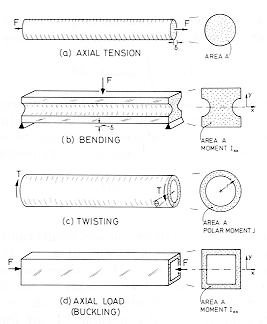| |
As implied
above, structural materials will be loaded in different ways when performing
their tasks. The diagram illustrates some modes of loading, in a real
structure a given element may be subjected to more than one such mode.
In
(a) the material is loaded in tension along its long axis. All materials
behave in an elastic manner and the application of a load will cause the length
of the element to change. If the uniaxial tensile load is too large the
material may fracture of develop a permanent shape change. A bending condition
is shown in (b) where a beam experiences a point load at its center and is
supported at both ends. Another bending configuration is that of a cantilever
where one end of the beam is held fixed and the free end is loaded. An aircraft
wing experiences this type of loading. Twisting about a long axis (c)
is also encountered by a wing structure and components such as the bottom bracket
axle on a bike also experience torsional loading. When materials are loaded
in compression (d) they may show an elastic response that is the opposite
of the tensile response in (a). If the material is thin walled or slender
another deformation mode can act and the material may buckle abruptly at some
critical load and cause component failure. Not only the section shape but
material properties will govern the response to these loading types.
|
|
|
|
|
|
|
|
|
|
|
|
